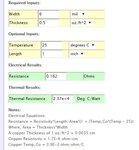dany.1986
Junior Member level 1
Hi
I am trying to figure out what would be the voltage seen by a load after the voltage drop in a wire/trace. I know that to calculate the voltage drop in a wire/trace we simply use the Ohm's law and then substract it from the voltage source to get the final voltage seen by the load. What I am confused about is why do we have to include the return path as well. In example, if Vsource=10 V, voltage drop of a source wire= 2 V then the voltage seen by the load would be 8 V, however, if we include the return wire which has the voltage drop of 2 V then the load would get 6 V. Why do we have to include the return path? Is it going to be the same case with the load directly on a PCB but with a long return trace to ground?
Thank you for your help.
I am trying to figure out what would be the voltage seen by a load after the voltage drop in a wire/trace. I know that to calculate the voltage drop in a wire/trace we simply use the Ohm's law and then substract it from the voltage source to get the final voltage seen by the load. What I am confused about is why do we have to include the return path as well. In example, if Vsource=10 V, voltage drop of a source wire= 2 V then the voltage seen by the load would be 8 V, however, if we include the return wire which has the voltage drop of 2 V then the load would get 6 V. Why do we have to include the return path? Is it going to be the same case with the load directly on a PCB but with a long return trace to ground?
Thank you for your help.
